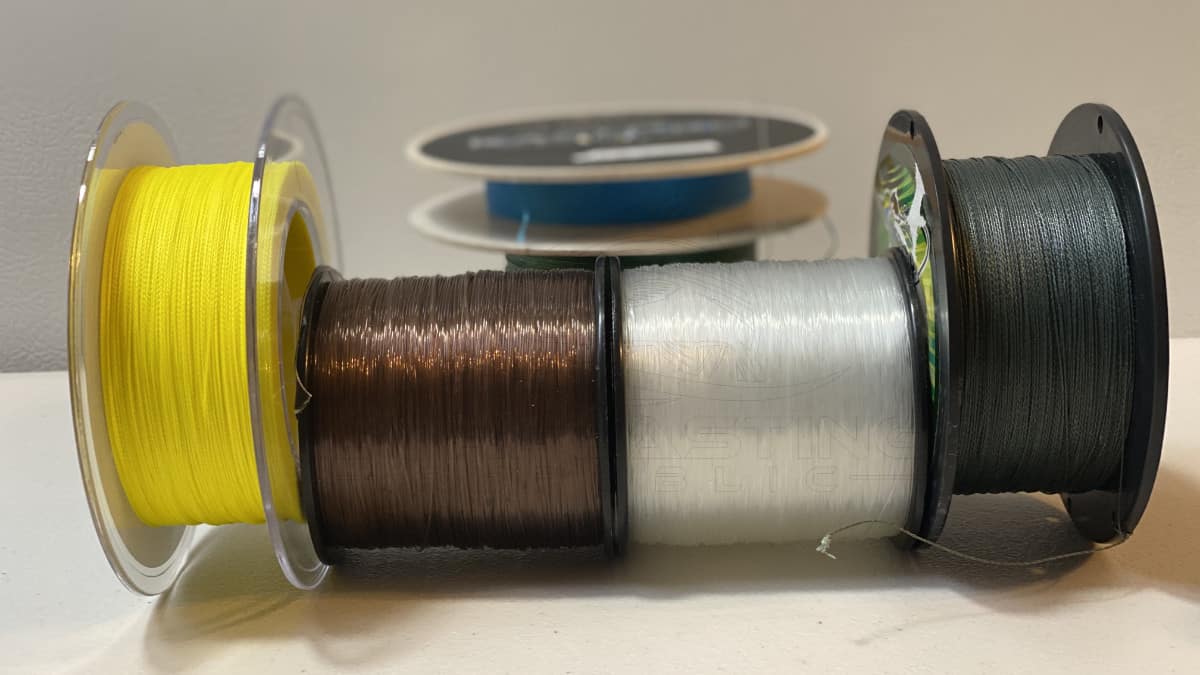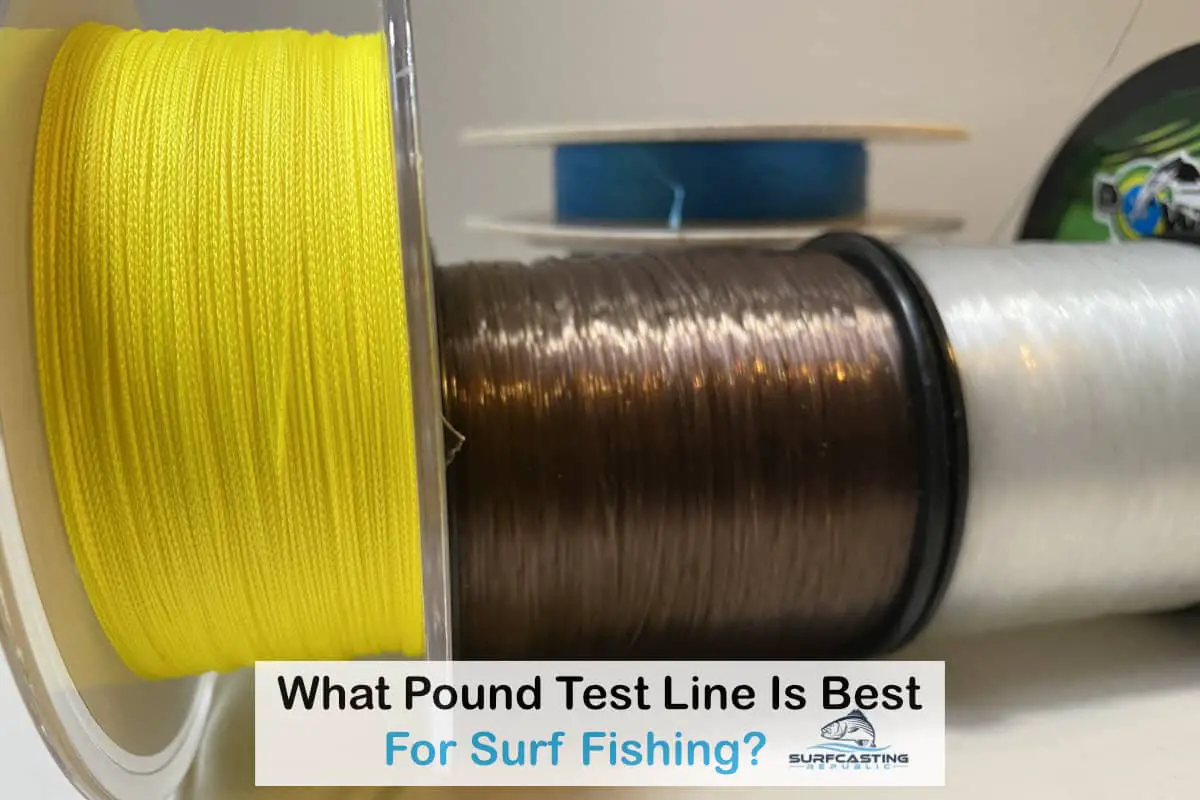Before you can even think to step out on the beach and cast a line as a surf caster, you need to make sure you have the right equipment and that this equipment is in good condition. This includes the rod, the reel, and your selection of a fishing line.
Of these three, your line selection is probably the most important as this is your connection to the surf and the fish. If the line cuts halfway through a catch, all your effort is lost and maybe even a trophy fish.
As a result, any anglers should invest in a good quality line with the correct strength, or pound test, for the specific fishing conditions. So how do you choose the best line and line strength for surf fishing?
For surf fishing, more experienced surf anglers can consider using braided lines with a 30-50lb test depending on the fish they after, for small fish recommended line strengths of 15 to 20 lb test for monofilament or braid lines. These lines need to be changed frequently to prevent wear and tear and to minimize the chances of an unexpected cut.
However, you have to be aware of the specific fishing conditions you will be facing, as these affect the optimal line strength you will need. In the following sections, I will discuss the things you need to consider to make the correct choice.
What exactly is the pound test?
Well, in simple terms, a line’s pound test is simply the amount of stress it can take before it snaps. So a 6lb line can take 6lbs of stress before its snaps, and anything less than this weight should be fine and keep your line safe.
How are lines tested to determine their strength?
You have to keep in mind that what is said on the line packaging can differ to a certain extent from real life, mainly because lines are tested in a controlled environment like a lab.
Here weight is attached, usually clamped onto the line to determine the weight the line can take, whereas, in real life, your hook will be tied to the line with a knot.
Knots are considered weak spots on the line, and even though your line may hold 15lb, the knot may not.
Most manufacturers also test their line in dry conditions, as the fishing line can become weaker when exposed to moisture for longer periods.
In fact, some fishing competitions such as the International Gas Fish Association (IGFA) actually conduct their own, wet strength tests on competitor’s lines, to determine “actual line strength.”
This has led some fishing line manufacturers to include wet testing in their line strength evaluations, and this can usually be seen on the line packaging as ” 20lb Line Class”, versus the normal ” 20lb Line Test”, for example (Source: Begin to Fish ).
).
So, is low pound test bad?
It is crucial to note that a low pound test does not necessarily mean your line will break if a heavy fish takes it, and depending on your circumstances, a low pound test will be fine.

This is because the reel will run with the line to give way when a fish swims off with it. Your line will only break if you set your drag system above the pound test of your line.
So the real down point of low pound test line is the fact that you have to set your drag low also.
Generally, it recommended that you set your drag for about 1/3 of your line’s strength, so if you have a 15lb line, your drag should be set to 5.
In surf fishing, your drag may end up being so low that reeling in a fighting fish may be very difficult.
You may have to wait for the fish to tire completely before reeling it in.
Yet, it is not impossible, and there are quite a few examples where heavy fish were pulled in with a low pound test line, you may just need a lot of patience to do it!
Is a high pound test line always good?
So why not simply choose a high pound test line all the time? Well, to start off with, it can be quite expensive.
High pound test lines are stronger and thicker and will allow you to have more control of the fish, but may cost you quite a lot of money.
The thicker line also limits you as to how much line you can fit on the reel – and this can be risky if you need to cast a bit farther into the surf.
Lastly, a thicker line will have more friction with the wind and air during casting and will be less stable in the surf.
Factors affecting the choice of pound test
As you can imagine, where and when you fish, for what fish species and under what circumstances, has a great influence on the strength of line you use.
Lastly, your personality will also influence your choice of fishing gear, and you can ask any fisherman, even with all these factors considered, you will eventually have to choose an option that is comfortable for you.
If you are a novice, this may involve some experimentation, but soon enough you will have your “swear-by’s” and “go-to’s” when it comes to surf fishing.
The section below will help you get started.
What Pound Test of Line is Best to Use with Different Types and Sizes of Sinkers for Surf Fishing?
When it comes to sinker options for surf fishing , the pound test of line you use will depend on the types and sizes of sinkers you choose. For lightweight sinkers, a lower pound test line will suffice, while heavier sinkers will require a higher pound test to prevent breakage.
, the pound test of line you use will depend on the types and sizes of sinkers you choose. For lightweight sinkers, a lower pound test line will suffice, while heavier sinkers will require a higher pound test to prevent breakage.
Types of fishing line
The three most common types of fishing lines are monofilament , fluorocarbon, and braided. Each of these three has different properties and affects your choice of line strength.
, fluorocarbon, and braided. Each of these three has different properties and affects your choice of line strength.
- Monofilament. These lines are easier to use for novice fishermen, as they are easy to knot and also relatively cheap. They do, however, absorb more moisture than the other line types and are more susceptible to wet breakage. Nylon monofilament lines have been shown to decrease in strength by up to 30% when wet. As an advantage, this type of line is more stretchable under pressure and is considered more “forgiving” when catching larger fish. Some also believe it handles potential chafing better, while others prefer tougher lines such as fluorocarbon.
- Fluorocarbon. These fishing lines do not absorb water and thus do not suffer from wet breakage, but factors like knots, shock resistance, and fish aggressiveness are factors to consider. For stretchability, it lies halfway between mono and braided and is virtually transparent. Although this may make it difficult for the angler to see, it’s easy to hide it from the fish.
- Braided. These lines have similar properties to fluorocarbon lines. It is preferred for its abrasion resistance and superb casting ability. Because it has virtually no stretch, it’s great for deep water fishing and helps the angler to feel the slightest bite from the fish. It can, however, be expensive and difficult to knot, and is usually preferred by more experienced fisherman.
Fish species
It goes without saying that the pound test of your choice of fishing line should roughly match the expected weight of the fish you are aiming to catch.
If you are considering larger game fish, a braided line with a pound test above 30lb is recommended.
You also have to keep in mind the teeth and or spines of the fish you are trying to catch. With ‘sharper’ fish, you will need a thicker line that is less likely to chafe.
Since line diameter is proportional to line strength, your line pound test will need to be higher with these fish.
Weather and location
As mentioned above, a heavier line or high pound test line will receive more drag during casting in windy weather. Similarly, the stormy sea will slur your line around much more if it is a thick line.
On the other hand, if you are fishing on rocky shores or near reefs that may end up cutting or chafing your line, a thicker line is preferred. This will push up your pound weight even if you target smaller fish.
I hope this guide is useful and will help you settle on the correct pound weight for your surf fishing needs! Good Luck!


